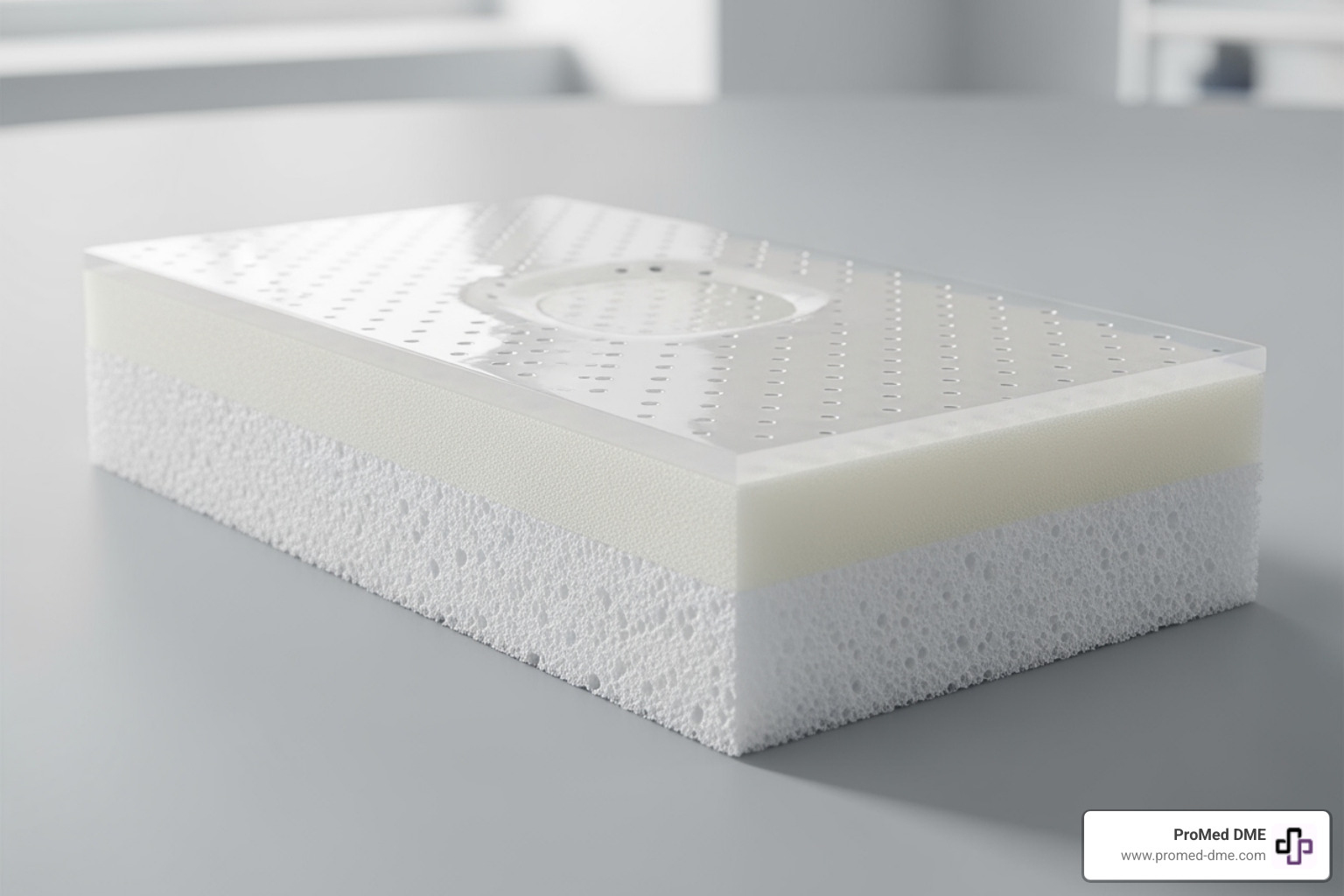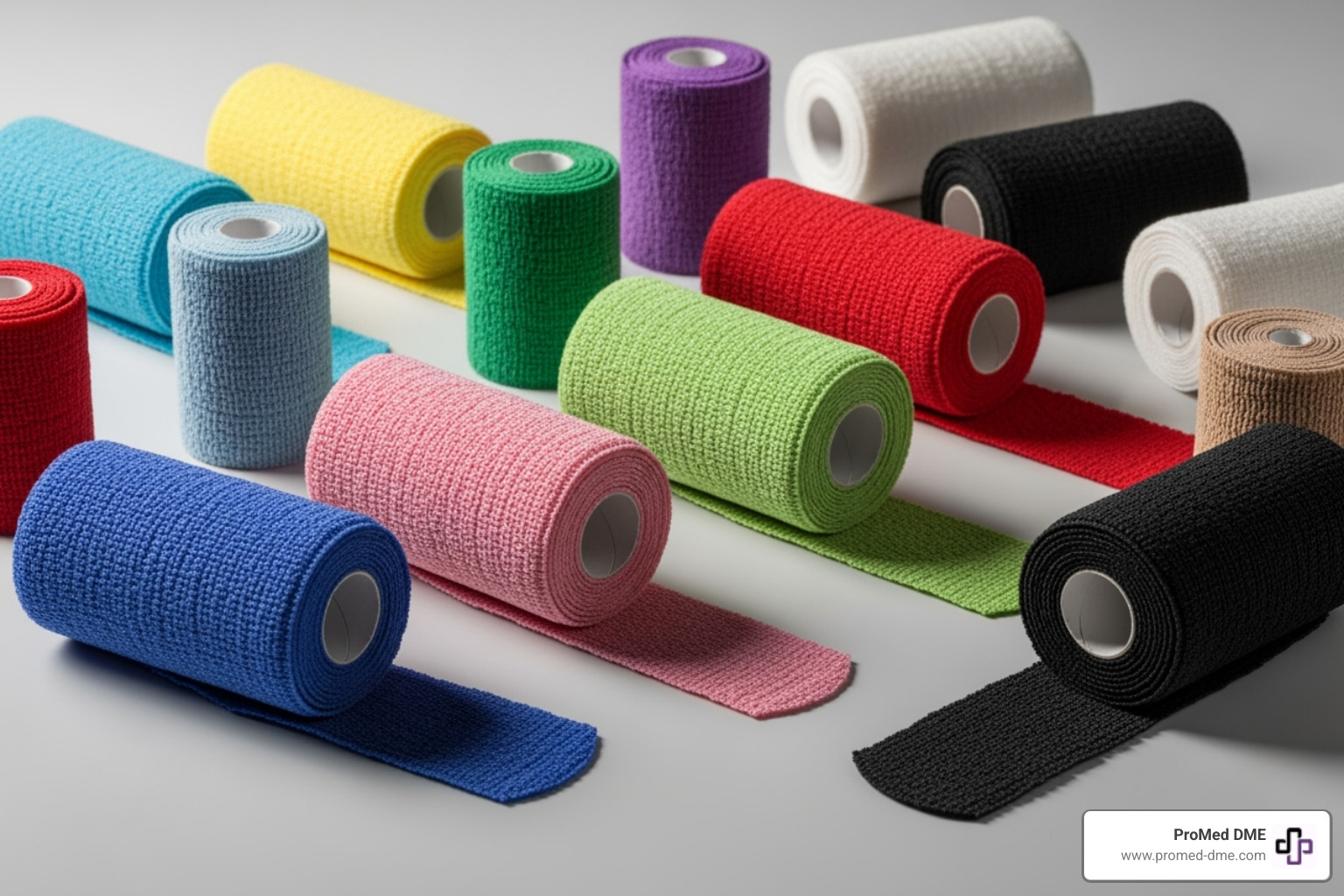The Ultimate Guide to Non-Stick Bandages for Burns
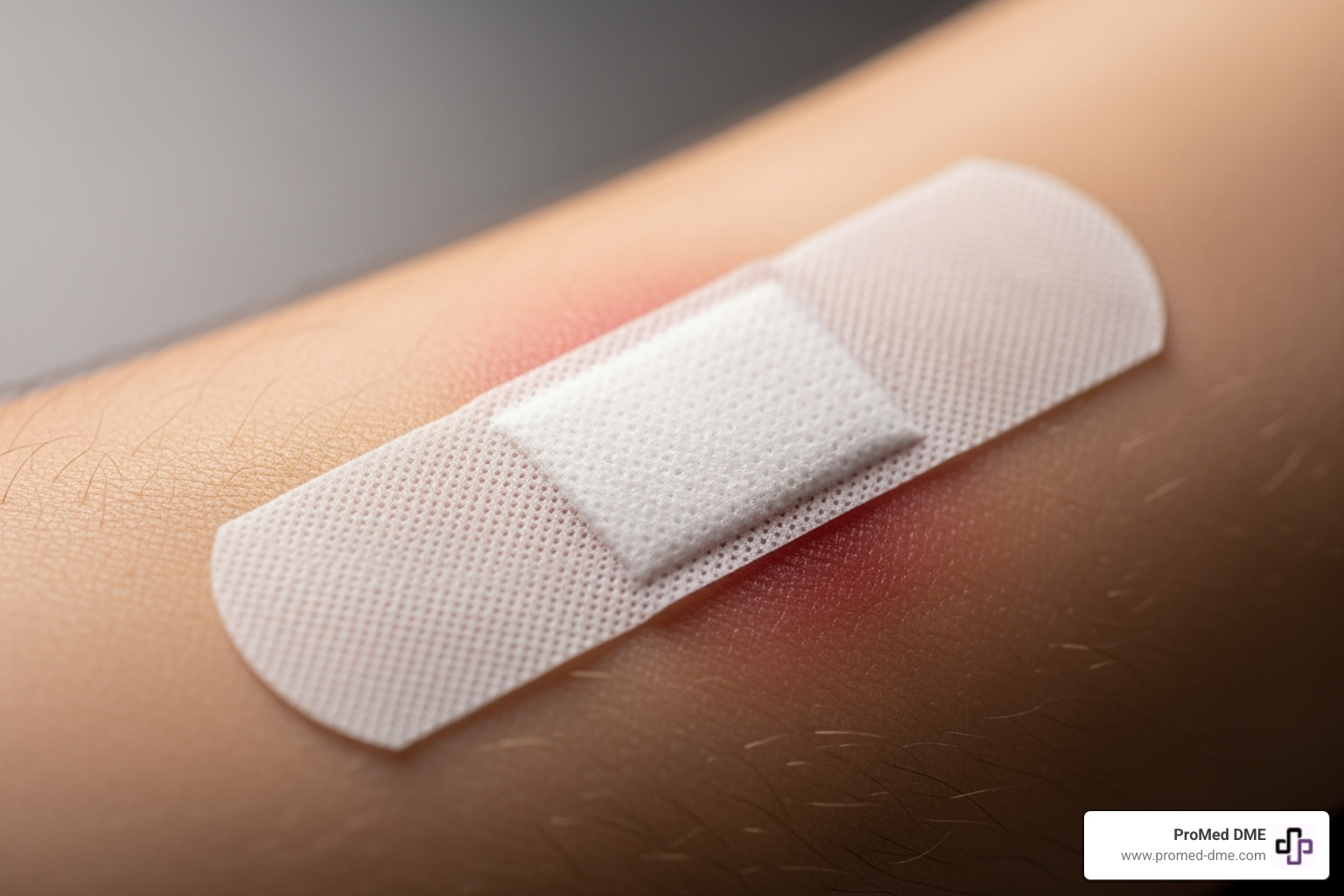
Why Non-Stick Bandages Are Essential for Burn Care
A non stick bandage for burns is a specialized wound dressing designed to protect your burn without adhering to the healing tissue, making changes virtually pain-free. These bandages feature a smooth contact layer that prevents sticking while maintaining the moist environment burns need to heal properly.
Quick Answer: What Makes Non-Stick Bandages Ideal for Burns?
- Pain-free removal - The non-adherent surface doesn't stick to the wound bed
- Protects new tissue - Prevents damage to fragile healing skin during changes
- Absorbs fluid - Wicks away discharge while keeping the wound appropriately moist
- Reduces infection risk - Creates a sterile barrier against bacteria and dirt
- Faster healing - Maintains the moist environment that speeds recovery by up to 50%
If you've ever experienced the pain of removing a regular bandage from a burn, you know the problem. Traditional gauze can stick to healing tissue, causing pain and potentially tearing away new skin growth. This sets back the healing process and increases scarring risk.
Non stick bandages for burns solve this problem through their specialized construction. They typically feature a poly film layer that directs fluid away from your skin, an absorbent core that manages discharge, and a non-adherent surface that lifts away cleanly. This design is particularly important for burns, which produce more fluid than typical cuts or scrapes.
Whether you're managing a minor kitchen burn or caring for a loved one recovering from a more serious injury, understanding how to properly use non-stick bandages can make a significant difference in comfort and healing outcomes.
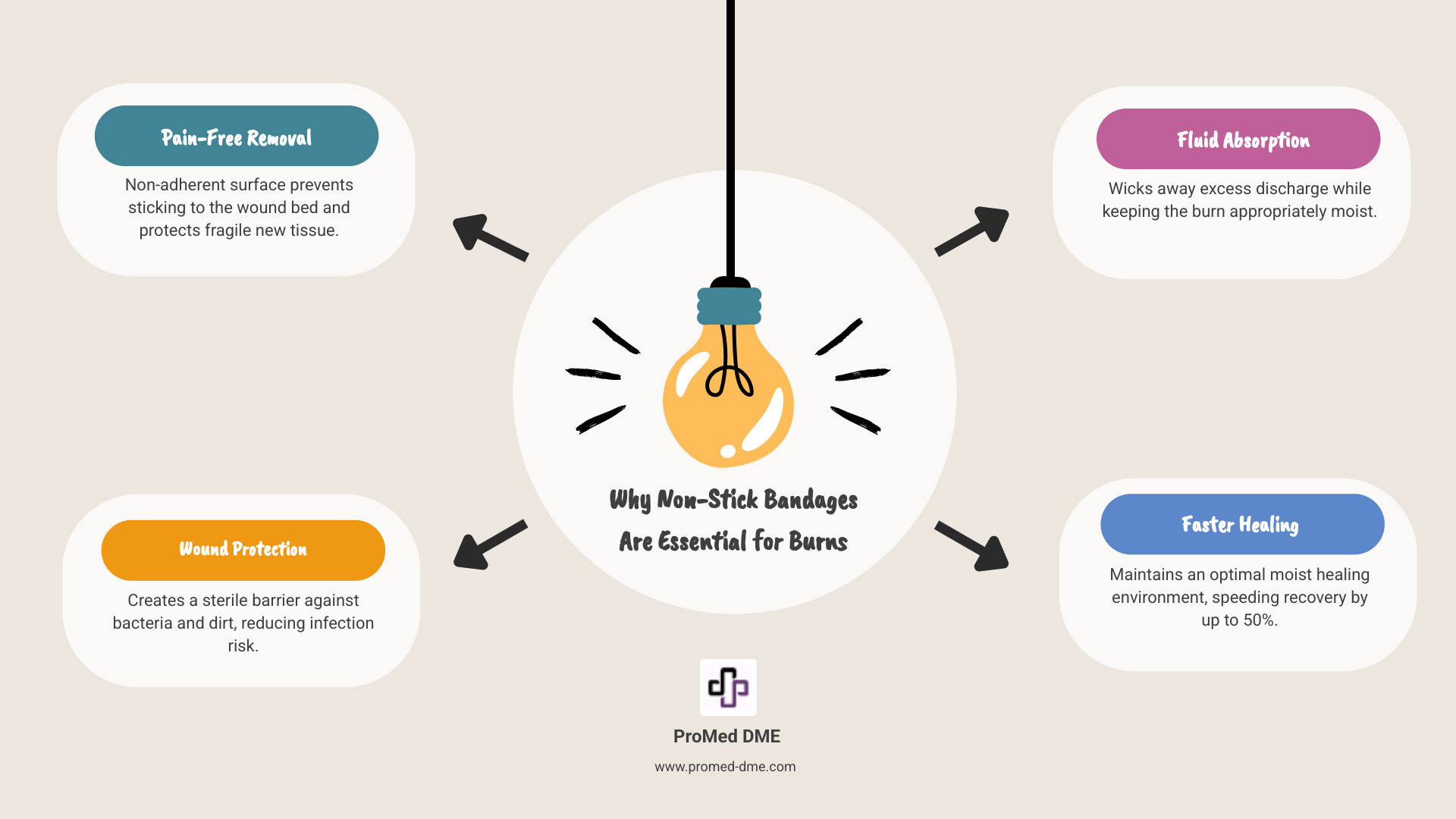
Understanding How Non-Stick Bandages Aid Burn Healing
If you've ever dealt with a burn, you know that choosing the right bandage can make all the difference between a comfortable recovery and a painful ordeal. Non stick bandages for burns are specifically designed to work with your body's natural healing process, not against it.
Think of a regular bandage as that house guest who overstays their welcome and makes a mess when they finally leave. Traditional gauze can embed itself into your healing burn, becoming part of the wound rather than just covering it. When removal time comes, it's like ripping off a scab – painful and damaging to all that fresh tissue your body worked so hard to create.
Non stick bandages for burns take a completely different approach. Their clever design creates a protective shield that keeps dirt and bacteria out while managing the wound's natural fluids. The real innovation is in how they interact with your healing skin – or rather, how they don't interact with it.
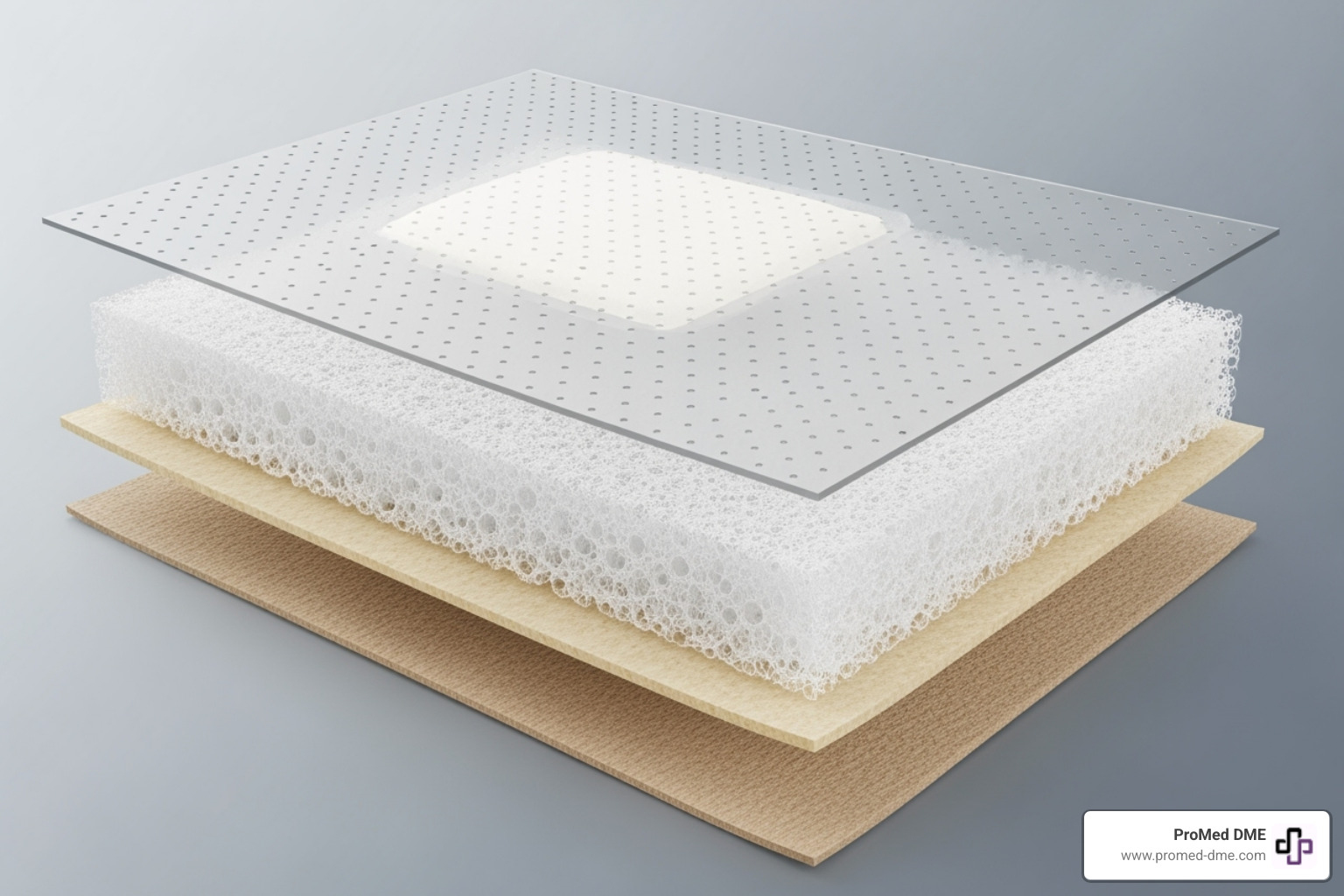
Most non-stick dressings have three distinct layers working together. The contact layer touches your wound with a smooth, perforated surface that lets fluid through without sticking. The absorbent core in the middle soaks up discharge and keeps everything clean. Finally, an outer film protects the whole package from outside contamination.
This design means you get genuinely pain-free dressing changes. No more gritting your teeth and bracing yourself. The bandage lifts away cleanly, leaving your delicate new skin cells exactly where they should be – on your body, not on the bandage. For burn wounds especially, this protection from re-injury is crucial. Every time you damage healing tissue during a dressing change, you're essentially hitting the reset button on your recovery.
Beyond comfort, these dressings actively promote faster healing. They manage fluid absorption beautifully, wicking away excess discharge while keeping the wound bed appropriately moist. This balance is the sweet spot where healing happens most efficiently.
How They Prevent Sticking to Wounds
The magic behind a non stick bandage for burns starts with its special contact layer. This surface is typically made from a smooth polyurethane film or similar material with tiny perforations throughout. These little holes are the secret – they're large enough to let wound fluid pass through, but the surface itself stays slick and non-adherent.
When you place the bandage on your burn, this smooth layer rests gently on the wound surface. As your burn produces fluid (which all wounds do as part of healing), it travels through those perforations into the absorbent core above. But here's the key: because the film doesn't absorb moisture itself and has that slippery surface, it never bonds with your skin or any scabs forming on the wound.
This prevents the nightmare scenario with regular gauze, where fibers become woven into your healing tissue. During dressing changes, you simply peel the bandage away. The scabs and new tissue stay put, exactly where they belong. This reduces pain dramatically and protects all that fragile new skin growth your body is working so hard to create.
The Role of a Moist Healing Environment
Here's something that might surprise you: keeping a wound moist actually helps it heal faster. For years, people thought wounds should "air out" and dry up, but modern wound care science has completely flipped that idea on its head.
A moist wound environment does several remarkable things. First, it speeds up cell growth. Your skin cells can migrate across a moist wound bed much more easily than a dry, crusty one – think of it like the difference between sliding across a water slide versus dragging yourself across sandpaper. This faster cellular migration means your wound closes more quickly.
Second, moisture reduces scarring. When wounds stay moist, they tend to form less obvious scars because the healing happens more evenly and smoothly. The environment also supports something called autolytic debridement, which is just a fancy way of saying your body can naturally clean away dead tissue more effectively when conditions are right.
Studies show that wounds kept in a moist environment can heal up to 50% faster than those allowed to dry out. That's a huge difference! Non stick bandages for burns, especially those with petrolatum coatings or hydrogel components, excel at maintaining this optimal moisture balance. They prevent your wound from drying out while still absorbing excess fluid.
If you're interested in learning more about how specialized dressings create ideal healing conditions, check out our guide on transparent wound dressings, which work on similar principles.
Choosing the Right Non-Stick Bandage for Burns
Not all burns are created equal, and neither are the bandages designed to treat them. Choosing the right non stick bandage for burns depends entirely on understanding the severity of your burn. What works beautifully for a minor kitchen mishap might not provide adequate protection for a more serious injury.
Let's talk about burn degrees in plain terms. First-degree burns are the mildest type—think of a typical sunburn. They affect only the top layer of skin, causing redness, some pain, and maybe a bit of swelling. These respond well to basic non-stick pads that keep the area protected and comfortably moist while healing.
Second-degree burns go deeper, affecting both the outer layer and the layer beneath. You'll see redness, significant pain, swelling, and those telltale blisters. The skin often looks wet or weepy. These burns need more specialized care. A non stick bandage for burns with good absorbency—like impregnated gauze or foam dressings—becomes essential here. These dressings manage the fluid your burn produces while maintaining that crucial moist environment we talked about earlier.
Third-degree burns are medical emergencies, plain and simple. They destroy all skin layers and potentially damage tissue underneath. The skin might look white, leathery, or charred. Surprisingly, these burns may hurt less initially because the nerves are damaged. These severe injuries require immediate hospital care—a bandage from your medicine cabinet simply won't cut it.
Here's an important rule of thumb: if your burn is larger than your palm, located on your face, hands, feet, genitals, or over a joint, or if you see large blisters forming, you need to see a doctor. We want you to heal properly, and sometimes that means getting professional help right from the start.
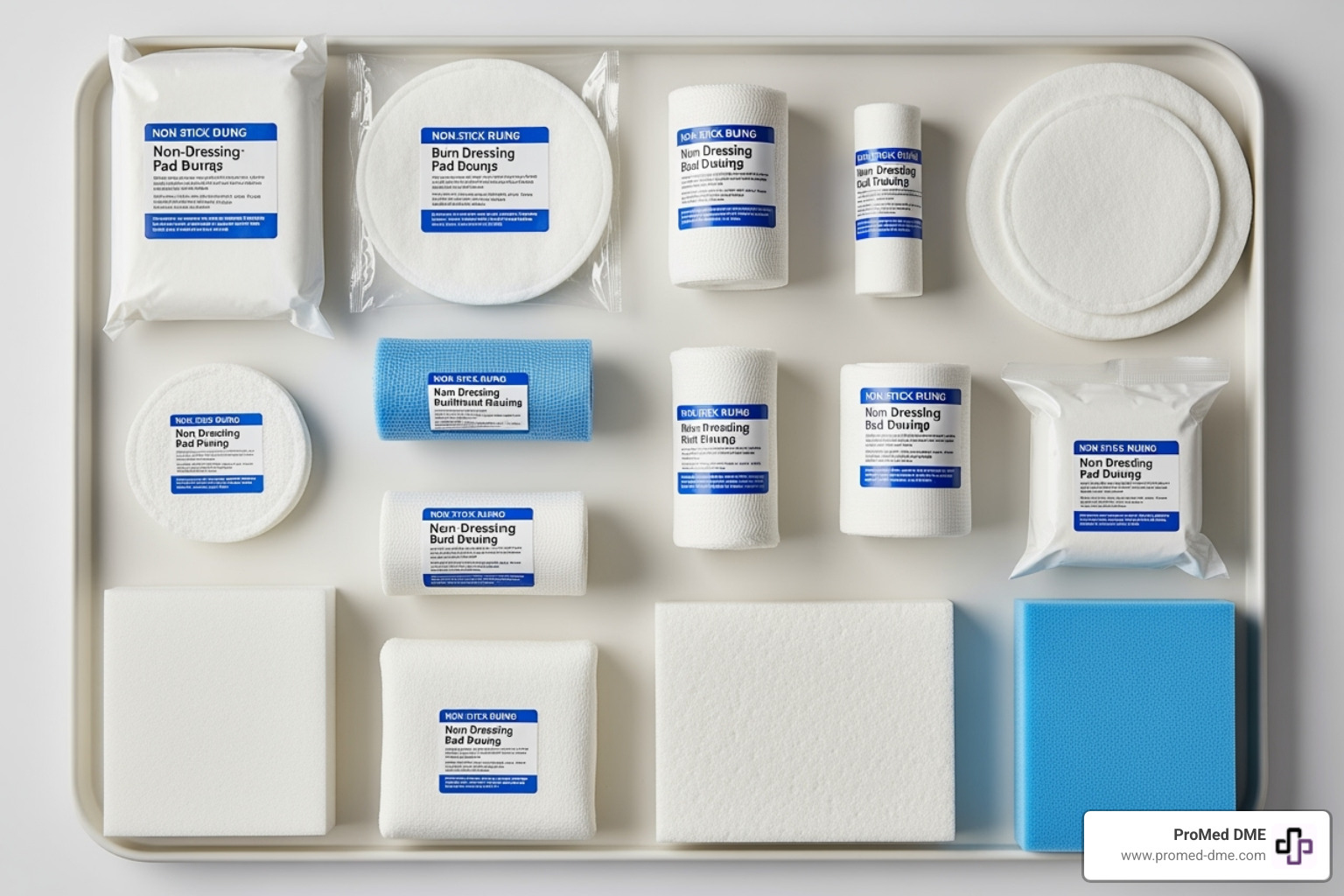
What Types of Non-Stick Bandages are Best for Burns?
Walking into a pharmacy and seeing dozens of bandage options can feel overwhelming. Let's break down the main types of non stick bandages for burns so you know exactly what you're looking for.
Basic non-stick pads are your go-to for minor burns. These are the ones you'll find in most first-aid kits, featuring a non-adherent layer over an absorbent pad. They're perfect for first-degree burns and minor second-degree burns that aren't producing much fluid. Simple, effective, and usually quite affordable.
Transparent film dressings are those thin, clear sheets made from polyurethane. They're waterproof and breathable, which means you can actually see how your burn is healing without peeling off the bandage. They work wonderfully for superficial burns or as a protective layer over another dressing. The catch? They don't absorb fluid, so if your burn is weepy, you'll need something else.
Impregnated gauze dressings are where things get interesting. These gauze pads come pre-soaked with healing substances like petrolatum or bismuth tribromophenate. The petrolatum versions are fantastic at keeping burns moist and preventing that dreaded sticking problem. Some, like Simpurity™ Xeroform Impregnated Gauze, even offer antimicrobial benefits. They're particularly effective for first- and second-degree burns because they address multiple needs at once.
Foam dressings are the heavy lifters of the dressing world. Made from soft polyurethane foam, these dressings are highly absorbent and perfect when your second-degree burn is producing moderate to heavy fluid. They're cushiony and comfortable, conforming nicely to body contours. Many come with a non-adherent contact layer, making them ideal burn dressings.
Island dressings offer convenience in a single package. They combine a non-adherent pad in the center with an adhesive border that sticks to healthy skin around the wound. No tape needed! They're great for minor burns when you want quick, easy protection.
Key Materials and Features to Look For
Understanding what's actually in your bandage helps you make smarter choices. Let's look at the materials and features that make certain non stick bandages for burns stand out.
Silicone-based dressings create an incredibly gentle contact with your skin. They're especially valuable if you have delicate or fragile skin, and they remove with minimal trauma. Think of them as the "kid gloves" of burn care.
Petrolatum is a tried-and-true ingredient that acts like a protective shield. Dressings impregnated with petrolatum keep your wound bed beautifully moist—which, as we've discussed, is exactly what burns need to heal efficiently. They prevent the dressing from becoming part of your scab, making changes much more comfortable.
Hydrogel dressings bring something extra to the table: cooling relief. Their high water content actually helps soothe burning pain while maintaining moisture. Some hydrogel dressings also have properties that discourage bacterial growth, which is a nice bonus.
Bismuth tribromophenate might be a mouthful to say, but this ingredient in certain impregnated gauze provides antimicrobial protection and even helps control odor. It's particularly useful for preventing infection in minor burns.
Beyond materials, pay attention to absorbency level. If your burn is producing a lot of fluid, you need a dressing that can handle it—like foam or certain non-stick pads with absorbent cores. Too little absorbency leads to a soggy mess that can actually soften and damage surrounding healthy skin.
Breathability matters too. Your dressing should allow air exchange while maintaining moisture—a delicate balance that quality burn dressings achieve through their layered construction.
Some dressings offer a waterproof outer layer, which is wonderful if you want to shower without worry. Others include antimicrobial properties that provide extra protection against infection—particularly valuable for burns, which are naturally vulnerable to bacterial invasion.
Potential Drawbacks and Limitations
Even the best non stick bandages for burns have their limits, and knowing when they're not the right choice is just as important as knowing when to use them.
If your burn is producing a lot of fluid, certain dressings won't keep up. Transparent films, for example, don't absorb anything. Using them on a weepy burn can lead to maceration—that's when surrounding skin gets too wet and starts breaking down, which actually delays healing and increases infection risk. When you're dealing with heavy drainage, reach for highly absorbent foam dressings or specialized non-stick pads instead.
While some dressings have antimicrobial ingredients, a bandage alone can't cure an infection that's already taken hold. If you notice signs of infection developing—which we'll cover in detail in a later section—you need to remove the dressing and call your doctor right away.
Deep or extensive burns require professional medical care, period. Third-degree burns and large second-degree burns are serious injuries that belong in a hospital, not under a home bandage. Non-stick dressings are wonderful for first-degree burns and minor second-degree burns, but they're not equipped to handle major burn management.
Finally, though it's rare, some people have sensitivities to materials in certain dressings. The adhesive in island dressings, petrolatum, or other components might cause irritation. If you notice worsening redness, itching, or irritation around (not in) the wound area, stop using that dressing and talk to a healthcare professional. At ProMed DME, we have a nurse on staff who can help answer questions about which products might work best for your specific situation—just give us a call.
A Step-by-Step Guide to Burn Care with Non-Stick Dressings
Taking care of a burn properly from the start can make all the difference in how quickly and comfortably it heals. At ProMed DME, we believe that having the right supplies and knowing how to use them transforms a painful experience into a manageable one. Let's walk through the proper way to care for a burn using a non stick bandage for burns.
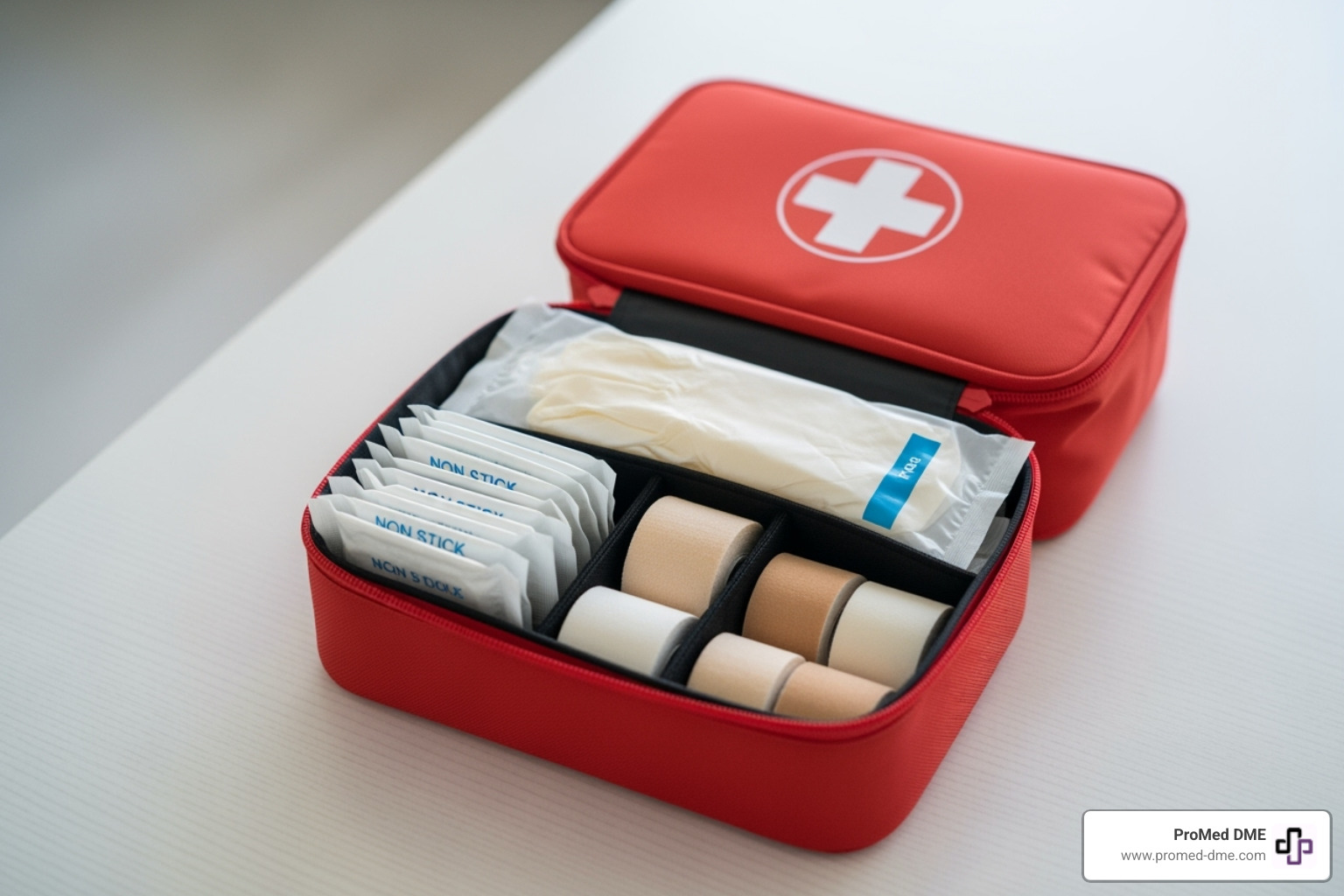
Before you begin, gather your supplies. You'll want your non stick bandage for burns, sterile gloves if you have them, medical tape or gauze to secure the dressing, and any antibiotic ointment your doctor recommended. Having everything ready means you won't be scrambling around with an exposed wound.
How to Apply a Non-Stick Bandage for Burns
The first thing you need to do is clean your hands thoroughly with soap and water. This might seem obvious, but it's the most important step in preventing infection. If you have sterile gloves available, put them on. If not, freshly washed hands work just fine for most minor burns.
Next, you need to cool the burn right away. Hold the burned area under cool running water for at least 10 to 20 minutes. This isn't just about pain relief, though that's certainly a welcome benefit. Cooling actually stops the burning process from continuing deeper into your skin and can significantly reduce tissue damage. Don't use ice or ice-cold water, as this can actually cause more harm.
Once the burn has been cooled, gently clean the area with mild soap and water. You're not scrubbing here, just removing any debris or dirt that might have gotten on the wound. A soft touch is key, as burned skin is incredibly sensitive and fragile.
After cleaning, pat the surrounding skin dry with a clean, soft cloth. The skin around the burn needs to be dry for any tape or adhesive to stick properly, but the burn itself should remain slightly moist. This is where the magic of a non stick bandage for burns really comes into play.
If your healthcare provider has advised you to apply antibiotic ointment, now's the time. A thin layer over the burn can help prevent infection. Products like bacitracin or Neosporin (the #1 doctor-recommended brand for infection prevention) are commonly used for this purpose. Just remember to follow your doctor's specific instructions, as not all burns require ointment.
Now for the actual dressing. Take your non stick bandage for burns out of its sterile packaging, being careful not to touch the part that will contact the wound. Most non-stick pads have a slightly shiny or smooth side, and this is the non-adherent surface that should be placed directly on the wound. Make sure the pad is large enough to cover the entire burn with a little healthy skin around the edges.
Finally, secure the dressing in place. If you're using an island dressing with an adhesive border, simply press the edges onto the healthy skin around the burn. For non-adhesive pads, you'll need to use medical tape or wrap it gently with gauze. The dressing should be snug enough to stay in place but not so tight that it restricts blood flow or causes discomfort.
How Often to Change the Bandage
How often you change your non stick bandage for burns depends on what's happening with the wound. For fresh burns that are producing a lot of fluid, daily changes are usually the way to go. This keeps the wound clean and lets you check on how it's healing.
As the burn starts to heal and produces less drainage, you might be able to go longer between changes, perhaps every two to three days. Some specialized dressings can even stay in place for up to two weeks, though you should always follow the specific instructions for your dressing type.
That said, there are clear signs that it's time for a change regardless of the schedule. If you see fluid saturation, where the outer layer of the bandage becomes visibly wet or stained with wound drainage, it needs to be changed immediately. A saturated dressing can't protect the wound effectively and can actually promote bacterial growth.
Other reasons to change the dressing include contamination from getting it dirty or wet, loosened edges where the dressing is peeling away from the skin, or increased pain under the bandage. Pain that gets worse rather than better could signal a problem that needs attention.
Your healthcare provider will give you specific guidance on how often to change your particular dressing, and following their recommendations is always your best bet.
Pain-Free Removal Techniques
The whole point of using a non stick bandage for burns is to avoid the pain of removal, but sometimes even these specialized dressings can stick a little. Here's how to make sure removal is as comfortable as possible.
Start with a gentle removal approach. Peel back the edges of the tape or adhesive border slowly, pulling parallel to the skin rather than straight up. This reduces the pulling sensation and is much more comfortable.
If the dressing seems to be adhering to the wound, try soaking it with saline. You can gently spray or drip sterile saline solution (or even clean water in a pinch) onto the dressing and let it sit for a few minutes. This softens any dried exudate that might be causing the dressing to stick.
For those times when a dressing is really stubborn, the oil-soaking method works wonders. This technique has been recommended by wound care experts and really does make removal painless. Simply apply clean cooking oil, baby oil, olive oil, or vegetable oil liberally to the bandage, making sure it soaks through to the wound contact layer. You can even cover it with plastic wrap to keep the oil in place and working. Let it sit for about half an hour, and you'll find the dressing peels off easily without damaging the delicate new skin underneath. For more detailed guidance on this technique, you can check out these expert tips on removing adhesive dressings.
Once the dressing is softened, use a steady peeling technique. Slowly and steadily peel the bandage back over itself, keeping it close to the skin surface. Patience is your friend here. Rushing and ripping it off quickly defeats the whole purpose of using a non-stick dressing in the first place.
With these techniques in your toolkit, caring for a burn becomes much less daunting. The key is being gentle, patient, and following the proper steps. Our nurse on staff at ProMed DME is always available if you have questions about wound care or need guidance on which products are right for your situation.
Monitoring the Wound: How to Spot Signs of Infection
Even with the best non stick bandage for burns protecting your wound, keeping a watchful eye on how it's healing is essential. While these specialized dressings create a protective barrier against bacteria and contamination, infections can still occur if bacteria find their way into the wound during dressing changes or if the burn is particularly susceptible.
At ProMed DME, all our wound care supplies are sterile, which means they're completely free from harmful microorganisms when you open the package. This gives you the cleanest possible start for your burn care. However, maintaining that sterile environment throughout the healing process requires careful technique and regular monitoring.
Think of wound monitoring as your early warning system. Catching an infection in its earliest stages can prevent a minor problem from becoming a major complication. The good news is that the signs of infection are usually quite clear once you know what to look for.

Key Warning Signs
Every time you change your non stick bandage for burns, take a few moments to really look at the wound. A little redness and mild swelling are perfectly normal for a healing burn, but certain changes should raise a red flag.
Spreading redness or increased swelling beyond the original burn area often signals that something's not right. If you notice the red area getting bigger or the swelling becoming more pronounced, your body might be fighting an infection. Similarly, yellow or green pus or discharge is never a good sign. Healthy wound fluid is usually clear or slightly pale yellow, but thick, cloudy, or discolored drainage suggests bacteria have moved in.
Your nose can be a surprisingly good diagnostic tool. A foul or unpleasant odor coming from the wound is a classic infection indicator. Trust your instincts here – if something smells off, it probably is.
Pain is your body's way of communicating, and worsening pain or increased tenderness around the burn can mean trouble. While some discomfort is expected during healing, pain that gets significantly worse or becomes throbbing could indicate an infection taking hold.
Watch for systemic signs too. A fever above 100.4°F (38°C), chills, or feeling generally unwell suggests the infection might be spreading beyond just the local wound site. This is particularly concerning and requires immediate attention. Finally, red streaks extending from the burn are an urgent warning sign – they indicate the infection is traveling through your lymphatic system and needs emergency care.
What to Do If You Suspect an Infection
If you notice any of these warning signs, don't wait to see if things improve on their own. Infections can worsen quickly, and prompt action makes all the difference in preventing serious complications.
Contact a healthcare professional immediately. Call your doctor, visit an urgent care clinic, or reach out to our dedicated nurse on staff at ProMed DME. We're here to help you steer these situations. When you call, be specific about what you're seeing – describe the color of any discharge, the extent of redness, whether you have a fever, and how the pain has changed.
A professional evaluation is essential because what looks like an infection might sometimes be a normal healing response, or conversely, what seems minor could be more serious than it appears. Your healthcare provider may need to examine the wound closely and possibly take a culture to identify exactly which bacteria are causing the problem.
If an infection is confirmed, you'll likely need antibiotics – either topical creams applied directly to the wound or oral medications taken by mouth. It's absolutely critical to complete the entire course of antibiotics as prescribed, even when you start feeling better. Stopping early can allow resistant bacteria to survive and cause the infection to return stronger than before.
Never try to treat a suspected burn infection with home remedies or by simply changing your dressing more frequently. While keeping the wound clean is important, established infections require professional medical treatment. Your health and safety are too important to risk with guesswork.
Frequently Asked Questions about Non-Stick Bandages for Burns
We know that caring for a burn can raise a lot of questions, especially when you're trying to balance healing with everyday life. Here at ProMed DME, we've gathered some of the most common questions we hear from people just like you who want to get burn care right.
Can I shower with a non-stick bandage on my burn?
This is one of the questions we hear most often, and for good reason—nobody wants to skip their daily shower! The good news is that you can usually shower with a non stick bandage for burns, but it requires a bit of care and attention.
First, check whether your dressing is waterproof or water-resistant. Many transparent film dressings are designed to be fully waterproof, creating a protective seal that keeps water out while you shower. Other non-stick dressings might be water-resistant but not completely waterproof. The product packaging should tell you what you're working with.
If your dressing isn't waterproof, or if you just want extra peace of mind, you can easily protect it. Simply cover the bandage with plastic wrap or use a waterproof bandage cover before you step into the shower. The goal is to keep the burn wound and the dressing dry. Try to avoid directing the shower stream right at the dressing, and definitely skip baths or swimming until your burn has healed—submerging the wound in water creates a perfect opportunity for bacteria to sneak in.
After your shower, check the dressing. If it's become wet or saturated, you'll want to change it as soon as possible. A wet dressing can lead to maceration (that wrinkly, overly soft skin you get after being in water too long) and increases your risk of infection. Signs of a wet dressing include visible moisture on the outer layer, a feeling of dampness, or the dressing losing its adhesion.
What is the difference between a non-stick pad and regular gauze?
If you've ever had a regular gauze bandage stick to a wound, you already know the painful answer to this question! But let's break down exactly what makes these two dressings so different.
Regular gauze is made from woven cotton fibers. It's highly absorbent, which is great for soaking up fluid, but those fibers have a downside. When you place regular gauze on a burn that's weeping or forming a scab, those cotton fibers can become embedded right into the healing tissue. It's like the gauze and your skin become one. When it's time to remove the dressing, those fibers don't want to let go—they stick stubbornly to the wound bed, causing significant pain and potentially tearing away the delicate new skin that's trying to grow. This re-injury can set back your healing and increase scarring.
A non stick bandage for burns takes a completely different approach. These dressings feature a specialized, smooth contact layer—often a perforated film or a material impregnated with silicone or petrolatum—that's engineered specifically to prevent sticking. This clever surface allows wound fluid to pass through to an absorbent layer beneath, while the dressing itself remains free from the wound bed. When it's time for a change, the dressing lifts away cleanly and comfortably, protecting that fragile new tissue and making the whole experience far less painful.
Both types of dressings have their place in wound care. Regular gauze works well for dry wounds or as a secondary absorbent layer over a non-stick primary dressing. But for burns, where the tissue is sensitive and needs gentle, undisturbed healing, non-stick pads are specifically designed for the job. The wicking properties of non-stick dressings pull moisture away from the wound surface while maintaining the optimal moist environment burns need, whereas regular gauze can either dry out the wound or stick to it—neither of which helps healing.
Should I pop a burn blister before applying a bandage?
We get it—when you see a blister, there's often a temptation to pop it. It looks uncomfortable, and you might think draining it will help. But here's the truth: you should generally leave burn blisters alone. Your body created that blister for very good reasons.
Think of a blister as nature's perfect bandage. The fluid inside isn't just sitting there—it's actively helping your burn heal. This fluid cushions the damaged skin underneath, keeps it moist (remember how important that moist healing environment is?), and actually contains growth factors and healing compounds that speed recovery. The blister's roof acts as a natural barrier, protecting the raw, vulnerable skin beneath from bacteria, dirt, and further injury.
When you pop a blister prematurely, you're removing this protective barrier and opening the door to several problems. First, you dramatically increase the risk of infection. The raw skin under a blister is incredibly vulnerable to bacteria, and once that protective covering is gone, germs have direct access. Second, you'll likely experience more pain—those nerve endings that were safely cushioned by the blister fluid are now exposed. Third, you're actually slowing down healing by removing the natural environment and healing factors your body carefully created.
So what should you do? Simply cover the blister gently with a non stick bandage for burns to protect it from accidentally rupturing. Most small to medium blisters will either reabsorb naturally as healing progresses, or they'll break on their own when the time is right. The skin underneath will be ready to face the world by then.
Now, there are exceptions to every rule. If you have a very large blister, one that's extremely painful, or one that's located over a joint where it's likely to rupture anyway, it's time to see a doctor or healthcare professional. They can safely drain it in a sterile environment if necessary, minimizing your risk of infection and complications. At ProMed DME, our nurse on staff is always available to help you determine when professional evaluation is needed. When it comes to burn blisters, when in doubt, it's always better to seek professional guidance than to take matters into your own hands.
Conclusion
If you've made it this far, you now know that managing a burn doesn't have to be a painful ordeal. The right non stick bandage for burns can transform the healing experience from something dreaded into something manageable and even comfortable. These specialized dressings do more than just cover a wound—they actively support your body's natural healing processes by protecting fragile new tissue, maintaining the optimal moisture balance, and most importantly, lifting away cleanly when it's time for a change.
Think about what we've covered: the pain reduction from ouchless removal, the faster healing times from maintaining that crucial moist environment, and the reduced scarring that comes from protecting delicate skin during its most vulnerable stage. These aren't just theoretical benefits—they're real outcomes that make a tangible difference in your recovery journey.
Proper burn care matters. Whether you're treating a minor kitchen mishap or helping a loved one through recovery, having quality supplies and knowing how to use them correctly can change everything. That's where we come in.
At ProMed DME, we're more than just a medical supply company. We're your partner in healing. Our extensive selection of wound care products means you'll find exactly what you need, from basic non-stick pads to specialized impregnated gauze dressings. And because we know that even the best products work better when you understand how to use them, we have a dedicated nurse on staff ready to answer your questions and guide you through the process.
We also understand that medical supplies can be expensive, which is why we work with most insurance plans to help minimize your out-of-pocket costs. Plus, we offer free shipping across the United States, so you can focus on healing instead of worrying about logistics.
Burns are stressful enough without adding the anxiety of painful dressing changes or uncertainty about proper care. With the right non stick bandage for burns and the support of our team, you can approach recovery with confidence.
Ready to experience the difference that quality wound care supplies and expert guidance can make? Explore our full range of wound care products today. We're here to help you heal—comfortably, safely, and with the care you deserve.
Related Resources & Articles
Stay informed with our informative blog posts.
Discover the ProMed Advantage
& Try Our Products
We offer free shipping and legendary customer service to ensure you receive the
best DME products for your needs.

